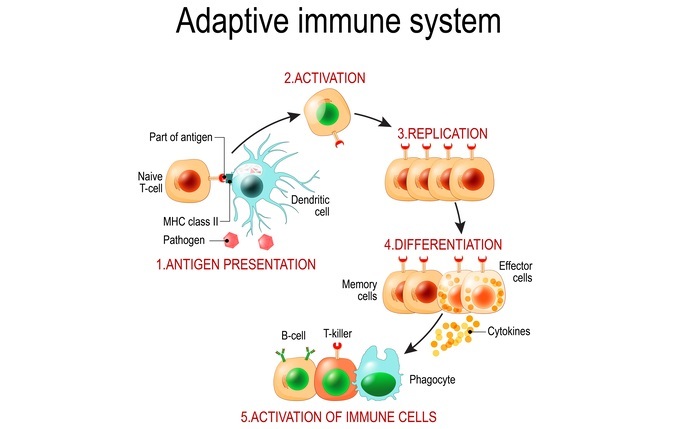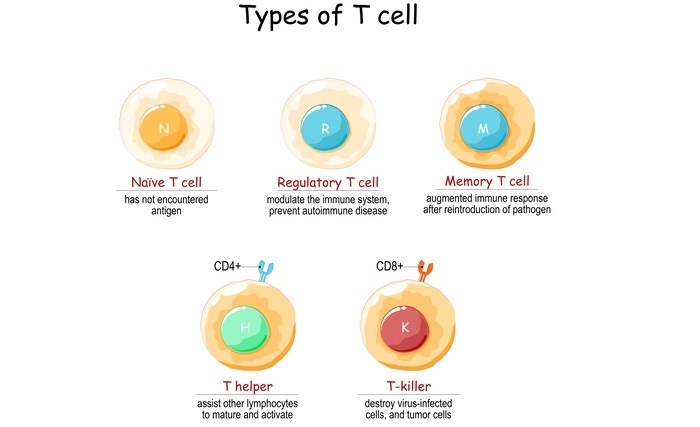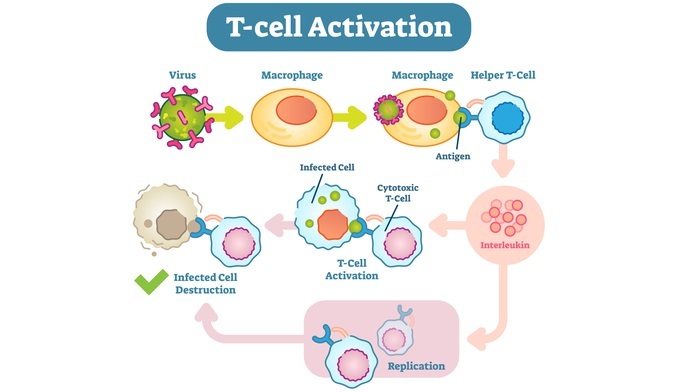
 Data Structure
Data Structure Networking
Networking RDBMS
RDBMS Operating System
Operating System Java
Java MS Excel
MS Excel iOS
iOS HTML
HTML CSS
CSS Android
Android Python
Python C Programming
C Programming C++
C++ C#
C# MongoDB
MongoDB MySQL
MySQL Javascript
Javascript PHP
PHP
- Selected Reading
- UPSC IAS Exams Notes
- Developer's Best Practices
- Questions and Answers
- Effective Resume Writing
- HR Interview Questions
- Computer Glossary
- Who is Who
T Helper Cells and Their Role in Adaptive Immunity
Introduction
T helper cells are a type of white blood cell that play a crucial role in the adaptive immune response. They are a subset of T cells that recognize and respond to specific antigens, which are molecules that are unique to pathogens. T helper cells work in conjunction with other cells of the immune system, including B cells and macrophages, to mount an effective immune response against invading pathogens.

The human body is constantly exposed to a wide range of microorganisms, including viruses, bacteria, and fungi. These microorganisms can cause infections that can lead to serious illnesses, such as pneumonia, meningitis, and sepsis.
To combat these infections, the body has evolved an intricate immune system that can recognize and destroy foreign invaders while sparing the body's own cells. The immune system is composed of two branches: the innate immune system and the adaptive immune system.
The Innate Immune System is the first line of defense against invading pathogens and includes physical barriers, such as the skin and mucous membranes, as well as cells that can recognize and destroy foreign invaders.
The Adaptive Immune System, on the other hand, is a more complex system that can adapt to specific pathogens and develop immunity to them. One of the key players in the adaptive immune system is the T helper cell, also known as Th cell.

Development of T Helper Cells
T helper cells are derived from the same precursor cells as other T cells in the bone marrow. These precursor cells migrate to the thymus, where they undergo a process of maturation and selection.
During this process, T cells that can recognize self-antigens are eliminated, while those that can recognize foreign antigens are selected to move on to the next stage of development.
Once T cells have completed their maturation and selection in the thymus, they migrate to the lymph nodes and other lymphoid tissues, where they await activation by foreign antigens.

Activation of T Helper Cells
Following are a few steps involved in the activation of T helper cells ?
T helper cells are activated when they encounter a foreign antigen that is presented to them by an antigen-presenting cell (APC), such as a dendritic cell or macrophage.
APCs phagocytose (engulf) the foreign antigen and process it into smaller fragments, which are then displayed on their surface in conjunction with major histocompatibility complex (MHC) class II molecules.
When a T helper cell recognizes a foreign antigen presented by an APC, it undergoes a process of activation.
This involves the binding of the T cell receptor (TCR) on the surface of the T helper cell to the foreign antigen-MHC class II complex on the surface of the APC.
This binding is further enhanced by co-stimulatory molecules, such as CD28 on the T helper cell and B7 on the APC.
Once activated, T helper cells undergo clonal expansion, which involves the proliferation of the T cell population that can recognize the foreign antigen.
This allows for the rapid amplification of the immune response and the generation of a large pool of T helper cells that can respond to the pathogen.

Functions of T Helper Cells
T helper cells have several functions in the adaptive immune response, including the activation of other immune cells, such as B cells and cytotoxic T cells, and the production of cytokines, which are signalling molecules that regulate the immune response.
Activation of B Cells
T helper cells play a crucial role in the activation of B cells, which are responsible for the production of antibodies. When a B cell encounters a foreign antigen, it internalizes it and presents it on its surface in conjunction with MHC class II molecules.
This activates nearby T helper cells, which bind to the foreign antigen-MHC class II complex on the surface of the B cell and release cytokines that stimulate the B cell to divide and differentiate into plasma cells, which are specialized cells that produce large amounts of antibodies.
Activation of Cytotoxic T Cells
T helper cells also play a critical role in the activation of cytotoxic T cells, which are responsible for the elimination of intracellular pathogens, such as viruses and certain types of bacteria.
When a cell is infected with a virus, it displays fragments of the virus on its surface in conjunction with MHC class I molecules. Cytotoxic T cells recognize these foreign antigen-MHC class I complexes and bind to the infected cell, leading to its destruction.
T helper cells play a crucial role in the activation of cytotoxic T cells by releasing cytokines that promote their proliferation and differentiation. This process, known as cell-mediated immunity, is essential for the elimination of intracellular pathogens that are hiding inside cells and cannot be targeted by antibodies.
Production of Cytokines
T helper cells are also responsible for the production of cytokines, which are signalling molecules that regulate the immune response. There are several subtypes of T helper cells, each of which produces a distinct set of cytokines that have different effects on other cells of the immune system.
Subtypes
The two main subtypes of T helper cells are Th1 and Th2 cells.
Th1 cells produce cytokines such as interferon-gamma (IFN-?) and interleukin-2 (IL-2), which promote cell-mediated immunity and the activation of cytotoxic T cells.
Th2 cells, on the other hand, produce cytokines such as interleukin-4 (IL-4), interleukin-5 (IL-5), and interleukin-13 (IL-13), which promote humoral immunity and the activation of B cells.
Role of T Helper Cells in Disease
-
Dysregulation of the T helper cell response can lead to the development of autoimmune diseases, in which the immune system mistakenly attacks the body's own tissues.
For example, in multiple sclerosis, T helper cells that recognize myelin, the protective coating around nerve fibers, attack and destroy myelin, leading to the symptoms of the disease, including muscle weakness, numbness, and difficulty with coordination.
T helper cells are also involved in the pathogenesis of allergic diseases, such as asthma and allergic rhinitis. In these conditions, Th2 cells produce cytokines that promote the production of IgE antibodies by B cells, leading to the activation of mast cells and eosinophils, which cause inflammation and tissue damage.
Furthermore, T helper cells are important in the immune response to viral infections, including HIV, hepatitis.
Current Prospects of Research
Overall, research on T helper cells is a rapidly evolving field with many exciting discoveries and potential applications. By continuing to investigate these cells and their functions, scientists can gain new insights into the immune system and develop novel therapies for a range of diseases and conditions.

